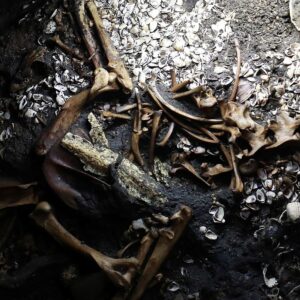In a country with even more pyramids than Egypt, Meroë is the pick of Sudan’s ancient sites, with 220 of the glorious steep-sided structures waiting to be explored.
 Royal Pyramids of Meroë at sunrise, Sudan.
Royal Pyramids of Meroë at sunrise, Sudan.
The car crunches across the sandy plain and deposits us, in silence, behind a hillock. The hour is early and a wash of violet stains the sky behind me, as I shoulder my small bag and set off westwards. The cool sand spills over my flip-flops, so I bend to remove them, planting my feet awkwardly into the deep dunes. The exertion pulls beads of sweat to my forehead despite the crisp morning air.
As I pace up the last incline, my eyes come level with what we’ve risen before dawn to see: the UNESCO-listed pyramids of Meroë. They’re part of a cache of royal burial sites whose 4,600-year-old, Toblerone-style peaks far outnumber those of Egypt and yet receive far fewer visitors. Negative news coverage has left travellers wary of Sudan — that, and the fact “the government isn’t interested in promoting our antiquities because it’s not Arab history,” according to my guide, Hitam El Nour. A Nubiologist (archaeologist specialising in Ancient Nubia) with a PhD in White Nile pottery, the only thing betraying his 47 years are the white hairs among his tight black curls.
We stand in the noiseless desert, the kataha (‘sandy air’) blowing softly around us until the sun rises above the horizon, lighting the pyramids like shards of honeycomb protruding from the sand. We’re surveying the northern site, where the great Kushite queens and kings were buried. Ruled by the Egyptians for 500 years, the Kushites absorbed all aspects of Egyptian culture, including the penchant for pyramids, albeit with their own twist: making them steeper with smaller bases. In 760BC, when the Egyptian empire was weakening, these Nubian emperors invaded and ruled as pharaohs for nearly a century during a period known as the Twenty-Fifth Dynasty. Their empire stretched from Khartoum to the Mediterranean Sea, with Meroë as the capital. Only discovered by Europeans in 1821, the pyramids were looted a decade later by Italian explorer Giuseppe Ferlini, although all but one were empty.
Today, we weave between the pyramids whose bases have history scratched into the stone: from the outlines of elephants, giraffe and gazelles showing that this area was once fertile grassland, to the graffiti left by British General Sir Herbert Kitchener’s soldiers passing by on their way to the Battle of Omdurman in 1898.
Several archaeologists, making the most of the cooler early morning hours, are painstakingly restoring the crumbling corners. They nod sagely as we pass, before returning to their work. One of the smaller pyramids, restored in the 1980s, bears a smooth rendered exterior. But it looks a little cartoonish and I veer towards the untouched structures. There’s an air of defiance about them as they stand firm against the sands that are trying to swallow them up.
Indeed, it was an act of resistance that led to the pyramids at Meroë being built in the first place. “History tells us that Kushite King Arakamani (Ergamenes) grew tired of the power wielded by the high priests, so when they sent the order for him to kill himself, he responded by having them all murdered instead,” says Hitam. The rebellion issued in a new era of Meroitic culture: the almighty Egyptian god Amun-Ra was downgraded in favour of the lion god Abedemak, the (still-undeciphered) Meroitic script was created and queens ruled the army. As we enter one of the narrow tombs, Hitam points to the walls. “See how the kings stand taller than the gods? You’ll never see that in Egypt,” he says. “The kings controlled everything, except death, so they built the pyramids for [their] immortality.” We exit into the burgeoning sunlight.
Unharassed by touts or hemmed in by barriers, I get a genuine sense of exploration as we duck into different doorways and I run my fingers lightly over the ancient etching on the walls. Eventually, we come to tomb number six, which belonged to the warrior queen, Amanishakheto. It was the first one destroyed by Ferlini in his search for gold and the one in which he hit the jackpot, unearthing a stash of jewellery hidden near the apex. In brutish fashion, he crowbarred the cartouche of her face off the slabs of stone at the entrance — but it has since been replaced with a replica, and I trace my finger over three scratches raked across her cheek. “What are these?” I ask. “They’re the tribal markings of Kushite women,” Hitam explains.
The heat is rising fast. Here, the dry air doesn’t just make you sweat; it blasts the moisture from you like a hairdryer, so we take a chance and make our way to the old Royal City of Meroë nearby. We find it closed for excavations, but at the gate meet Mawya, a third-generation guardian whose grandfather helped the first archaeologists unearth the site in 1909. I ask him for stories of the past. He leans on the door frame and looks far into the distance. “My grandmother told me that during the rainy season, they’d all run to collect the gold when it washed from the tombs to the surface.”
It’s time to return to Khartoum, but en route we stop at the home of Mr Hassan and his wife, Zakia. Sitting on weathered plastic chairs, we enjoy the cool shade of their whitewashed compound. Hitam looks at me to see if I’ve noticed anything, but he needn’t have. As Zakia hands me a flute of piping hot coffee, I catch sight of a trio of tribal markings flowing, like dry riverbeds, towards her jaw. They’re exactly like those marking the likeness of Queen Amanishakheto at Meroë. A true Nubian, Zakia’s ancestors are direct descendants of the Kushites. All of a sudden ancient history doesn’t seem so distant.





